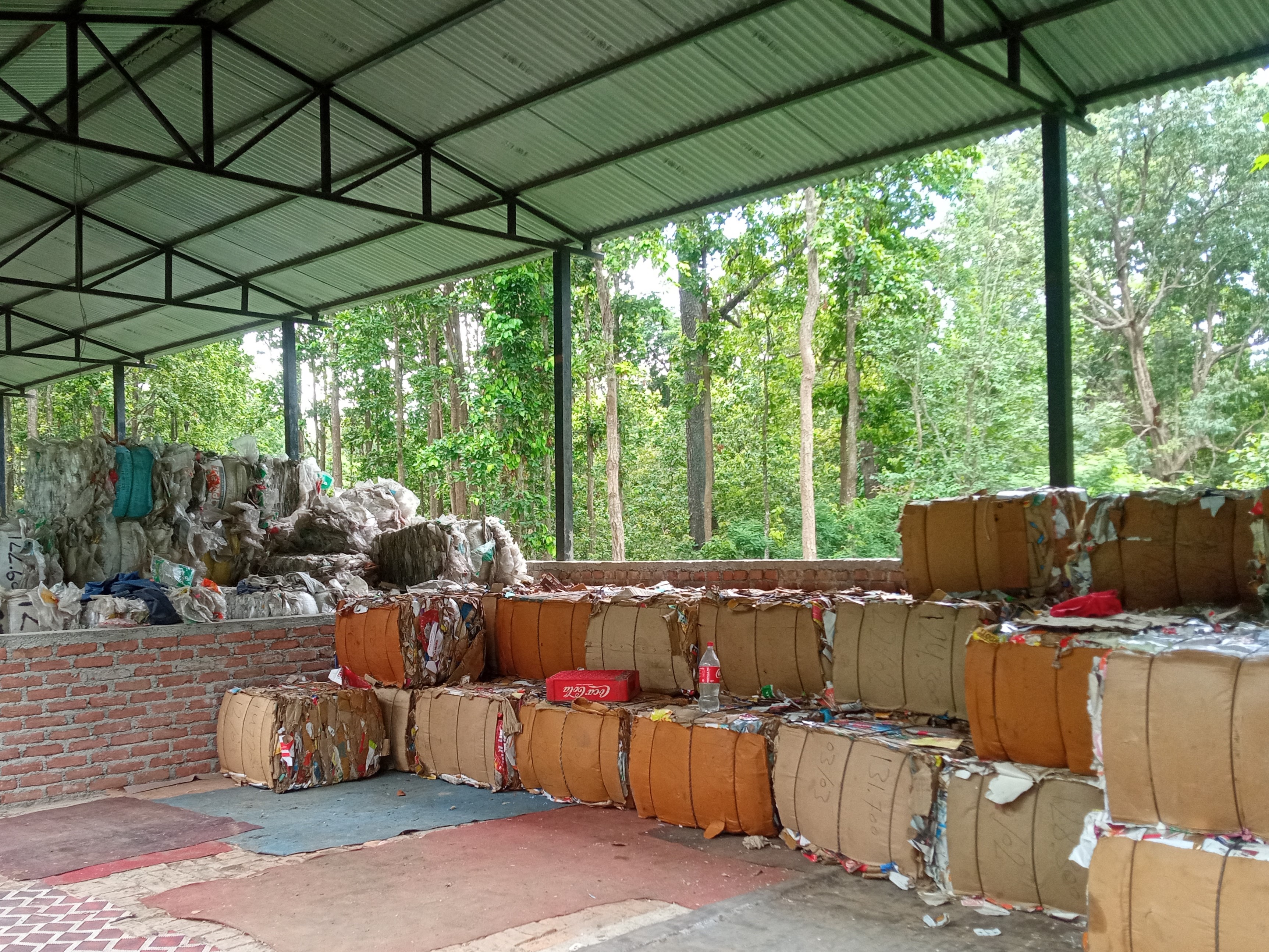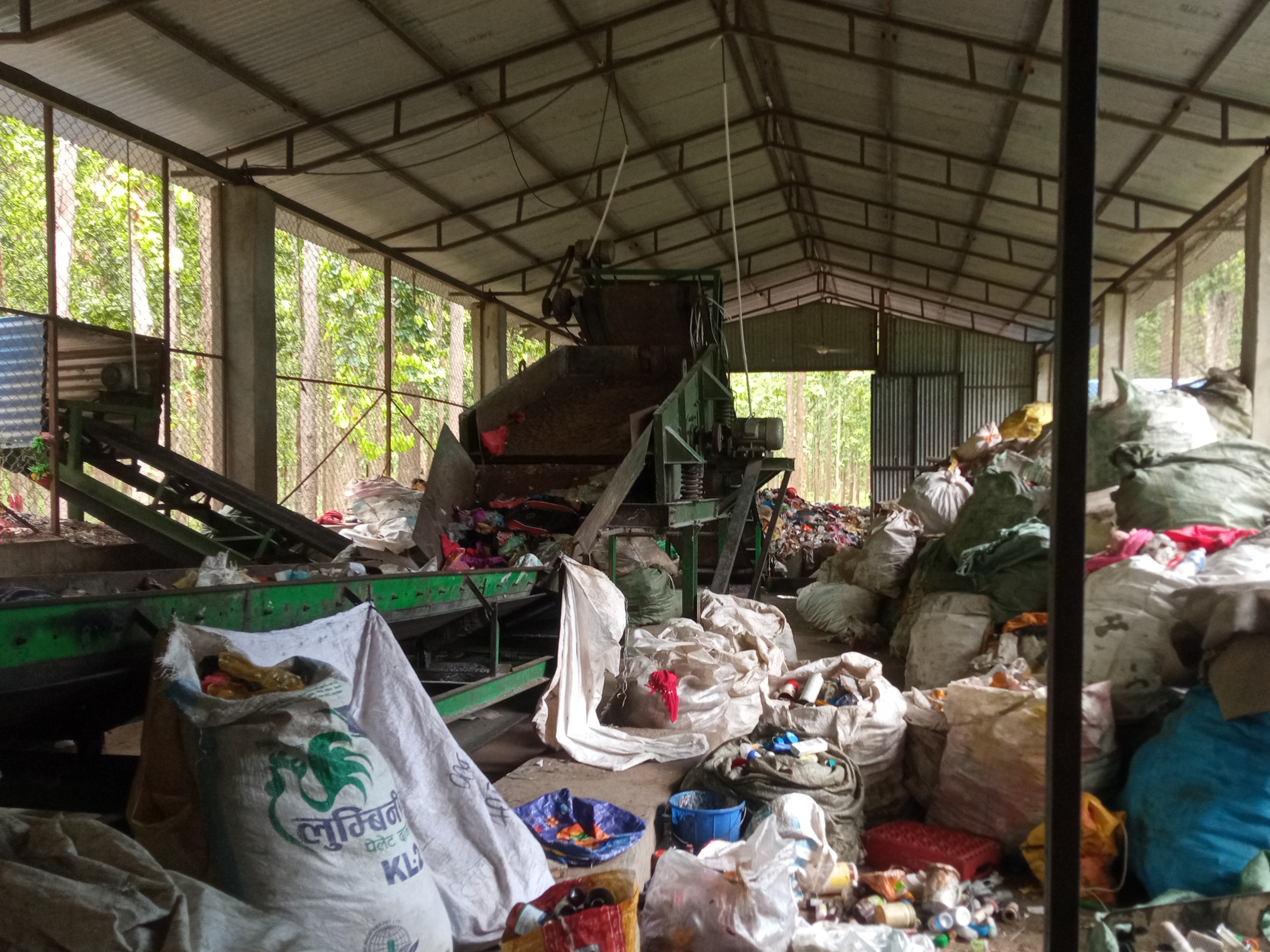Butwal is setting an example in sustainable waste management through cooperative efforts and strong female participation. Despite limited resources, local groups are driving change for a cleaner, more inclusive city.

July 11, 2025
Shivanagar-7, Butwal, Rupandehi

Plastic waste being segregatedat the Material Recovery Facility (MRF) in Butwal.
Photo: DevPulse/ Prakriti Kafle
Butwal is setting an example in sustainable waste management through cooperative efforts and strong female participation. Despite limited resources, local groups are driving change for a cleaner, more inclusive city.
Key Words: Butwal waste management, Material Recovery Facility, gender equality, sanitation Nepal, urban waste Butwal, cooperative waste model Nepal
As Nepal’s cities expand, so does the crisis of managing urban waste. But in the heart of Lumbini Province, Butwal offers a remarkable—yet under-recognized—model: a cooperative-run Material Recovery Facility (MRF) that not only tackles waste sustainably but also champions gender equality in the sanitation sector.
Located in Ward No. 7, Shivnagar, the Butwal Sanitation and Environment Protection Cooperative Organization was formed four years ago with a shared vision: to promote a “Clean and Green Butwal”. With 1,200 shareholders and 11 formal owner-members, the cooperative operates under a tripartite agreement between Butwal Sub-Metropolitan City, the Shivnagar Community Forest Users Group, and the cooperative itself.
At present, it provides daily waste collection services to over 5,000 households and 25 institutions across two wards. Although initially designed to serve four wards (7, 8, 9, and 11), its coverage shrank due to political complications with Butwal Sub-Metropolitan City and a lack of sustained funding.
“If we had the financial and infrastructural support, we would expand to more wards,” said Krishna Bahadur Karki, Chair of the Cooperative.
Despite these setbacks, the MRF remains a model of decentralized waste management for Butwal.
Waste is collected in segregated form—organic and inorganic waste on alternate days—and recyclable plastic is compressed and sold to contractors. On average, the facility processes two tons of organic and one ton of inorganic waste daily.

Stacks of sellable plastics in compact block form in Material Recovery Facility, Shivangar 7, Butwal
Photo: DevPulse/ Prakriti Kafle
Beyond its technical operations, what truly sets this MRF apart is its genuine commitment to gender inclusion. Out of 30 total workers, 18 are women, and not just token hires. Female workers are prioritized and actively involved in both technical and administrative roles.
“We believe women bring discipline, detail, and dedication to this field,” said Chair Karki. “They are naturally inclined towards cleanliness and management, which makes them a perfect fit for sanitation roles.”
This sentiment is reflected on the ground. During a focused group discussion, the female workers—laughing, singing old Bollywood tunes during lunch—shared a sense of pride in their work. “We receive our salary every 15 days, and it’s equal to that of male workers,” said Sangita Thapa, who has worked at the MRF for two years. “We get gloves, boots, masks, and aprons. We feel safe and respected.”
Tila Magar, another female worker who worked for two years, added, “We haven’t received formal training yet, but we would love to learn more. It would help us grow professionally.”
The cooperative pays NRs. 7 per kilogram for plastic bottles and bags, and NRs. 3 per kilogram for paper waste, which many of the women sort manually with care and precision.
Following a detailed observation of the Material Recovery Facility, efforts were made to gather local perspectives from residents of the corresponding wards regarding the initiative led by the cooperative. Just outside the Shivanagar Community Forestry area, a visit was made to the home of a 56-year-old community forestry user and MRF beneficiary (name withheld on request).
When asked about the impact of the MRF, he shared, “We are extremely happy and relieved by this facility. Previously, dogs and monkeys would scatter waste along the roads. Although separating organic and inorganic waste daily can be a bit hectic compared to simply discarding mixed waste, it is a good initiative, and we are very happy with it.”
While the MRF runs a tight operation, financial sustainability remains a pressing concern. The estimated annual operating cost is just NRs. 300,000. According to Narayan Bahadur Ghimire, advisor of Butwal Sanitation and Environment Protection Cooperative Organization, “Building another similar facility in Butwal would cost up to NRs. 30,000,000—funds the cooperative currently does not have.”
The primary revenue sources include household waste collection fees (NRs. 70 per month) and institutional fees (NRs. 500–4,000), along with the sales of plastic blocks. Still, the earnings are barely enough.
“Many customers delay payments, and maintenance costs are rising,” said Gehendra Raj Neupane, Secretary of Butwal Sanitation and Environment Protection Cooperative Organization. “Plus, 10% of our income goes to the sub-metropolis as per contract”.
Initial support for the MRF’s infrastructure came from:
Butwal Sub-Metropolitan City: NRs. 4.5 million for fencing and shade
Lumbini Province: NRs. 5.5 million
GIZ (Germany): NRs. 3.2 million for awareness and machinery
But follow-up support has been minimal. In addition to collecting and segregating waste, the Material Recovery Facility had also been converting organic waste into animal feed and compost manure. A small-sized organic compost plant had been established for this purpose.
However, this activity was discontinued in the Nepali month of Bhadra 2081 B.S. (August/September 2024) due to the high expense and labor involved in manual composting. The cooperative has since requested a larger compost plant and an excavator from the Butwal Sub-Metropolitan City, but the budget has not yet been approved.
"We established the fencing and shades for the Material Recovery Facility, and we haven’t planned to extend the facility in other wards, as we have permitted private contractors to collect waste from other wards. After the completion of those contracts, this existing MRF can extend to other wards too,” said Thagishwor Pokhrel, Section Officer of the Sanitation and Waste Management Section of Butwal Sub-Metropolis.
The Material Recovery Facility hit a financial breaking point in the Nepali fiscal year 2080/081 (2023/24). Since then, the cooperative has been advocating for further support to ensure operational continuity and impact. A recent contract between the Butwal Sub-Metropolitan City and the United Nations Development Programme (UNDP) has opened a new window of opportunity.
The cooperative has submitted a proposal requesting financial support for infrastructure expansion, staff training, and the reactivation of compost production. It now plans to start a vegetable, fruit, and flower nursery for the benefit of users from Wards 7, 8, 9, and 11, from the compost produced from the organic wastes.
A crucial meeting with the municipality is scheduled for July 3, 2025, where the cooperative hopes to present its case for urgent investment. Yet, the vision persists.

Inside view of the Material Recovery Facility (MRF) at Shivanagar-7, Butwal
Photo: DevPulse/ Prakriti Kafle
Butwal’s cooperative-led Material Recovery Facility offers more than just waste collection—it is a living model of local governance, gender-inclusive employment, and sustainable urban planning. But what it demonstrates is the transformative potential of local leadership, community cooperation, and gender inclusion in tackling a growing urban crisis.
It is not a perfect system—it faces chronic underfunding, bureaucratic hurdles, and operational constraints. Its future remains precarious—tied to uncertain municipal politics, limited funds, and delayed infrastructure approvals. Without timely support, the very blueprint it represents risks stalling before it can scale.
What this community needs is not applause, but action. With the right investments, Butwal’s quiet success could become a replicable model—not just for Nepal’s secondary cities, but for much of South Asia struggling to manage waste with dignity, equity, and environmental responsibility.

By sharing valuable information and sparking inspiration, we aim to foster growth, innovation and brighter opportunities for future generations.
Contact us